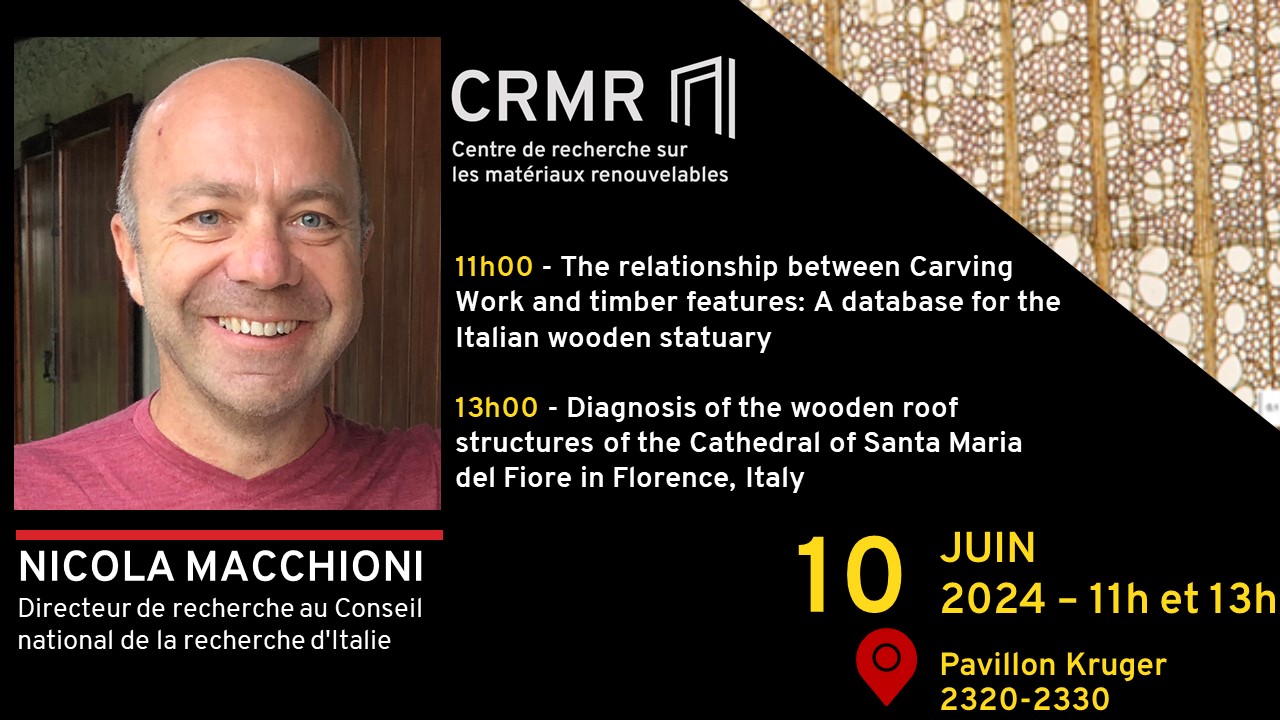Nicola Macchioni’conferences, Director of Research at Italy’s National Research Council!
The Renewable Materials Research Center invites you to attend two conferences presented by Nicola Macchioni, Research Director at the Italian National Research Council (CNR), Institute of Bioeconomy (IBE) in Sesto Fiorentino, and Head of the Wood Anatomical Characterization Laboratory. The conferences will take place on June 10, 2024 in room 2320-2330 of the Gene-H.-Kruger Pavilion at Laval Uniersity, Quebec City, and will be in English.
The first lecture, entitled « The Relationship between Carving Work and Timber Features: A Database for the Italian Wooden Statuary », will take place on June 10, 2024 at 11am.
The second lecture, entitled « Diagnosis of the wooden roof structures of the Cathedral of Santa Maria del Fiore in Florence, Italy », will take place on June 10, 2024 at 1 pm.
About the speaker
Nicola Macchioni obtained his doctorate in wood science from the University of Florence in 1992. From 1990 to 1994, he was an external collaborator at the University of Turin. In April 1994, he joined the Italian National Research Council at the Institute of Wood Technology in San Michele all’Adige. In 1997, he was appointed permanent researcher and head of the wood anatomy laboratory at the Institute of Wood Research (IRL) of the Italian National Research Council in Florence. In 2002, the IRL became the Institute of Trees and Wood (IVALSA), and was integrated into the Institute of Bioeconomy in 2019. Since 2020, Nicola Macchioni has held the position of Research Director at the Bioeconomy Institute of Italy’s National Research Council in Sesto Fiorentino, where he is also Head of the Wood Anatomical Characterization Laboratory.
He also has teaching experience, particularly in anatomy and wood identification. He is the author of over 180 articles. His research interests focus on the anatomical characterization of wood, with particular emphasis on its use in cultural heritage. He has carried out in-depth studies of various historic wooden structures, including Florence Cathedral, Palazzo Ducale in Venice, Palazzo Corsini in Rome, the Royal Palace in Naples, the Church of the Nativity in Bethlehem, Mons Cathedral in Belgium and Palacio Benicarlò in Spain. As coordinator of the group drafting the EN standard on historic timber structures (EN 17121), he has played a crucial role in this field. His research also focuses on water-impregnated archaeological wood, concentrating on diagnosing the state of conservation and characterizing consolidation treatments. In addition, he is exploring wooden statues, developing a specific database describing the relationship between sculptural work and different types of wood.
Conference summaries
The Relationship between Carving Work and Timber Features: A Database for the Italian Wooden Statuary
« Wood has a wide range of applications in the artistic field, most of the time used as a support for works of art, for example, in panel paintings. Compared with stones and metals, wood is by far the material most utilised for sculptures. Through the identification of wood species, a study of timbers used in statuary in Europe, with a deeper exploration of the works of art preserved in Italy, can provide further insights for historical–artistic studies. Indeed, in reality, generic wood does not exist, but there are different timbers. This is a notion that the wood fine carving artists/craftsmen knew well. The initial idea of this study was to verify whether timber features could influence the formal results in figurative carving; therefore, a specific database that had been developed to catalogue the carving works was used for which the identification of wood species was carried out through reliable methodologies. The aim of this research was to analyse the relationship between the timber species used in statuary, the formal results of carving, and the thickness of the preparatory layer, through the data stored in a specific database, called ArISStArt. It contains a sort of registry of artistic carving and inlay works: For each artefact, a record was compiled consisting of different fields, which contains the historical–artistic information available, including the images of the artefact and also types of timber/s used for its creation, with a link to the relative field. The number of the recorded artefacts is, at present, 480. On most of the artefacts, more than one sample was taken; therefore, the total number of identifications carried out corresponds to 691. Based on the results, the vast majority of wooden statuary is carved from hardwoods, more specifically hardwoods, with diffuse porosity and small variations in density within the growth ring. The timber most present is poplar, followed by lime and walnut. With the listed three timbers, almost 80% of the artefacts recorded in ArISStArt were created.»
Diagnosis of the wooden roof structures of the Cathedral of Santa Maria del Fiore in Florence, Italy
« The construction of the cathedral of Florence, one of the largest churches in the world, demarks the typical skyline of the city with its huge dome. The construction began in 1296, while the church was consecrated in 1436. The considerable size of the church implies the usage of wooden structural elements that are dimensionally unique, originated from a forest in Italy that hardly finds similar examples. The importance of historical wooden structures, considered an integral part of the cultural heritage and memory, is also to be found in the safe use of the architectural asset. In 2020, a two-year project was launched, dedicated to the development of a protocol for the investigation of the wooden structure of the Cathedral roof, so to establish its state of conservation. The final aim is to proceed with a plan for a suitable restoration interventions and allow a correct restoration of the structures, thus guaranteeing a long-lasting service life of the building. The complete diagnostic followed the procedures described in the EN 17121:2019 standard. The results of the survey were elaborated and returned in tabular and graphical form to have a complete database, containing the information for each structural member and joint. On the basis of the results obtained, it was possible to carry out structural evaluations: structural analysis and verification, finite elements models of the stresses, structural assessment.The described results allow the managing body to estimate how and where to carry out any necessary intervention, fundamental for the maintenance and safety of the wooden structure and therefore, of the whole building ».
This event is organized by the Renewable Materials Research Center in collaboration with Professor Tatjana Stevanovic Janezic. If you have any questions about the event, please contact Besma Bouslimi (besma.bouslimi@sbf.ulaval.ca).


